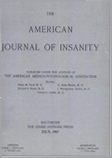PHYSICAL THERAPY
Abstract
I. Ninety-five per cent (95%) of reporting psychiatric hospitals have used hydrotherapy for many years on classical indications and with satisfactory results.
II. Heliotherapy (including thermo—photo—and actinotherapy) has, during the last decade, come into extensive use to improve metabolism and promote resolution of many physical ailments.
III. Static currents are used in only 6 per cent of hospitals.
IV. Low voltage currents have come into use mostly during the last four years in 28 per cent of hospitals, being prescribed mostly for constipation and paralysis.
V. High frequency currents are used in 40 per cent of hospitals for fever induction and treatment of inflammatory conditions.
VI. Other methods of pyretotherapy are malaria, typhoid and non-specific protein injections, electric blankets and short wave radio transmitter.
VII. Roentgentherapy is used in 16 per cent of hospitals mostly for malignancy and dermatologic disorders.
VIII. The average hospital has two full time technicians usually specially trained, the work being directed by members of the medical staff.
Access content
To read the fulltext, please use one of the options below to sign in or purchase access.- Personal login
- Institutional Login
- Sign in via OpenAthens
- Register for access
-
Please login/register if you wish to pair your device and check access availability.
Not a subscriber?
PsychiatryOnline subscription options offer access to the DSM-5 library, books, journals, CME, and patient resources. This all-in-one virtual library provides psychiatrists and mental health professionals with key resources for diagnosis, treatment, research, and professional development.
Need more help? PsychiatryOnline Customer Service may be reached by emailing [email protected] or by calling 800-368-5777 (in the U.S.) or 703-907-7322 (outside the U.S.).



